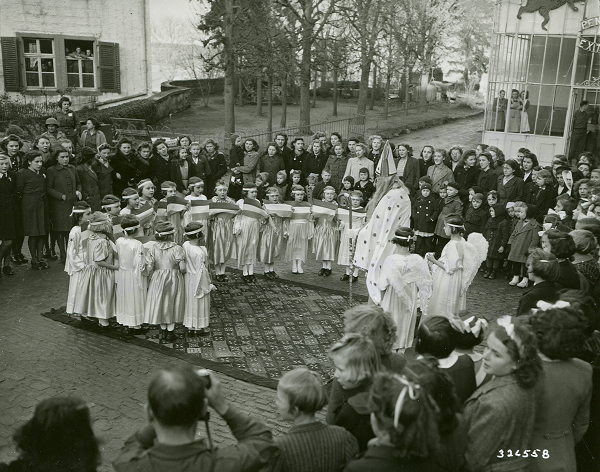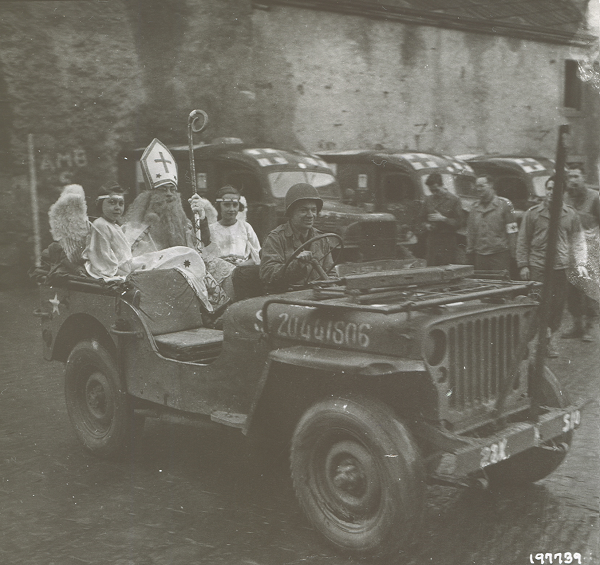A GI’s act of kindness to war-weary kids in a Luxembourg town gave them joy and made him an enduring legend—the “American St. Nick.”
Corporal Richard W. “Dick” Brookins of the 28th Infantry “Keystone” Division had a secret alter-ego. He didn’t realize it until 1944. But that year, early in December, the lanky 22-year-old from Rochester, New York, became “the American St. Nick,” able to bring joy to the war-weary children of Wiltz, Luxembourg. Ever since, the people of Wiltz have honored Brookins and his fellow American GIs for an act of kindness that gave traumatized children a reason to smile again.
On December 5, 1944, the eve of St. Nicholas Day, Brookins showed up at the convent school in the centuries-old Wiltz Castle to begin his transformation, donning vestments borrowed from a local Catholic priest. He had been talked into the role by his friend Corporal Harry Stutz, who served with him in the Keystone Divisions’ 112th Infantry Regiment, and who had decided to give Wiltz’s children a party for St. Nicholas Day.
As author Peter Lion tells it in his 2003 book The American St. Nick: Based on the True Story of the 28th Division’s Compassion and Heroism in WWII Europe, Stutz told Brookins, “I think we should give this town a Christmas party, A St. Nicholas Day.”
Stutz went on to say “For hundreds of years here in Wiltz, they had a celebration on the fifth of December, the eve of St. Nicholas Day. A man dressed as St. Nick paraded through the town and gave candy to the kids. Kids here haven’t celebrated St. Nicholas Day for nearly five years because of the war. Some of them have never seen St. Nick at all.”
Brookins height made him Stutz’s first choice for the role of St. Nicholas. So, despite initial reluctance, Brookins soon found himself in ecclesiastical vestments, tying on an abundant white beard made from rope. Finally, donning a long cape and bishop’s miter made by Wiltz’s nuns, he became de Kleeschen (pronounced “duh KLEE-shun”), as Luxemburgers call St. Nicholas of Myra, a 4th-century bishop in the ancient region of Lycia in Asia Minor.
Accompanied by two little girls dressed as angels, Brookins rode by jeep (rather than the traditional carriage) from the castle to the town square to preside over a traditional St. Nicholas party for the children of Wiltz. The whole town turned out. A GI played guitar, costumed children performed song and dance numbers, and boys and girls stepped up to receive treats—candy that GIs had donated from their rations, gathered into bags by the nuns.

After about 40 minutes, de Kleeschen and his retinue returned to the castle for more treats, more performances, and a chance for more children to meet St. Nicholas, who was able to speak with them in German (another reason Brookins was right for the role).
Less than two weeks later, Adolf Hitler would launch a last-ditch, all-out offensive to break through the Allied lines on Germany’s western border. The German assault into the forested Ardennes region would push American units backward, deep into Belgium and Luxembourg, into towns where war had become all too familiar. One of those towns was Wiltz, where the 28th Division would fight to defend the town early in the massive and bloody struggle known as the Battle of the Bulge. Many Keystone Division GIs and many civilians of Wiltz were killed or injured in the fighting.
After the Allied victory over Nazi Germany, Europe rebuilt. Memory of sacrifices and heroism in the war led to the creation of monuments and commemorative events to honor the valiant. And in Wiltz, memory of the American St. Nick led to an annual reenactment of the events of December 5, 1944. In 1977, representatives of the town contacted Brookins and invited him to return to Wiltz with his family for the commemoration. He accepted the invitation and played St. Nicholas again for Wiltz’s children, complete with the jeep ride.
The reenactment of the visit of the American St. Nick has continued every year since then, carried on by the organization Oeuvre Saint-Nicolas. Brookins himself returned to Wiltz seven times over the years to played his special role.
In December 2014, at age 92, Brookins visited Wiltz again. Though now on oxygen and too frail to play St. Nicholas, he took the jeep ride as an honored guest, and greeted his many admirers at the celebration. Two women interviewed at the event for a video on the website of the newspaper Luxemburger Wort had been children at the time of the American St. Nick’s first visit in 1944.
Wiltz erected a monument to Brookins in 2009, with a plaque reading:
to Richard Brookins, the American GI of the 28th Infantry Division,
honorary citizen of Wiltz, honorary member of the Oeuvre Saint Nicolas Wiltz
St. Nick for the children of our town, in December 1944
Brookins’s agreement to play the patron saint of children back in 1944 made him a legend. As he told Luxemburger Wort, “I’m the luckiest man in the world.”
US Army Signal Corps footage uploaded to YouTube by Joe Ekaitis
Captions (from top)
• In character as de Kleeschen—St. Nicholas of Myra—Corporal Richard “Dick” Brookins of the 28th Infantry “Keystone” Division rides out from Wiltz Castle to meet an expectant crowd in the town square of Wiltz, Luxembourg, on December 5, 1944. He and his angel attendants are going the US Army way—by jeep instead of the traditional carriage. US ARMY SIGNAL CORPS PHOTO. NATIONAL ARCHIVES
• Little girls holding Luxembourg flags sing for the American St. Nicholas in the square in Wiltz. The saint towers over the crowd, thanks to Brookins’s height—a factor that led event organizer Corporal Harry Stutz to recruit Brookins for the role. US ARMY SIGNAL CORPS PHOTO. NATIONAL ARCHIVES
Links
1944 footage on YouTube
CNN video from 2009
Luxemburger Wort video from 2014
St. Nicholas Center story



FOLLOW US »
